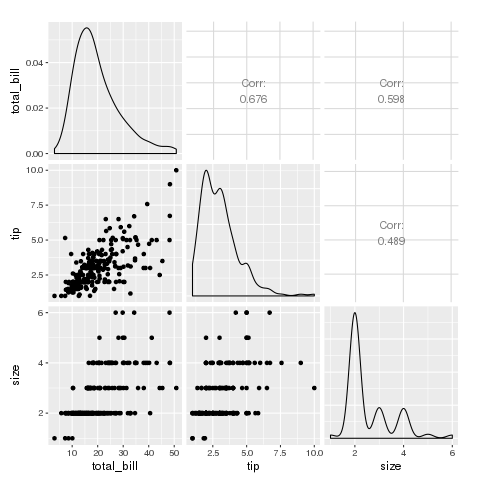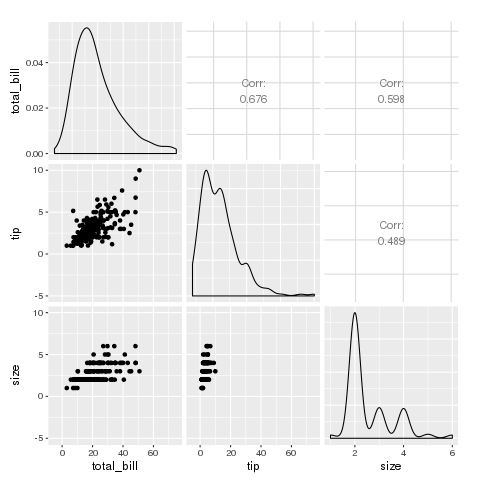Based on the answer from @see24, I noticed that the x-axis of the diagonal density plots is off. This can be mitigated in two different ways:
- by additionally defining a function
diagfun for the diagonal elements of the ggpairs output.
- in case one doesn't care too much about the vertical axis of the density plots, one can simply add
scale_x_continuous(...) and scale_y_continuous(limits = c(-1.5,1.5)) globally to the ggpairs() output.
Method 1
library(GGally)
#> Loading required package: ggplot2
#> Registered S3 method overwritten by 'GGally':
#> method from
#> +.gg ggplot2
df <- read.table(text =
" x y z w
1 0.49916998 -0.07439680 0.37731097 0.0927331640
2 0.25281542 -1.35130718 1.02680343 0.8462638556
3 0.50950876 -0.22157249 -0.71134553 -0.6137126948
4 0.28740609 -0.17460743 -0.62504812 -0.7658094835
5 0.28220492 -0.47080289 -0.33799637 -0.7032576540
6 -0.06108038 -0.49756810 0.49099505 0.5606988283
7 0.29427440 -1.14998030 0.89409384 0.5656682378
8 -0.37378096 -1.37798177 1.22424964 1.0976507702
9 0.24306941 -0.41519951 0.17502049 -0.1261603208
10 0.45686871 -0.08291032 0.75929106 0.7457002259
11 -0.16567173 -1.16855088 0.59439600 0.6410396945
12 0.22274809 -0.19632766 0.27193362 0.5532901113
13 1.25555629 0.24633499 -0.39836999 -0.5945792966
14 1.30440121 0.05595755 1.04363679 0.7379212885
15 -0.53739075 -0.01977930 0.22634275 0.4699563173
16 0.17740551 -0.56039760 -0.03278126 -0.0002523205
17 1.02873716 0.05929581 -0.74931661 -0.8830775310
18 -0.13417946 -0.60421101 -0.24532606 -0.1951831558
19 0.11552305 -0.14462104 0.28545703 -0.2527437818
20 0.71783902 -0.12285529 1.23488185 1.3224880574")
upperfun <- function(data,mapping){
ggplot(data = data, mapping = mapping)+
geom_density2d()+
scale_x_continuous(limits = c(-1.5,1.5))+
scale_y_continuous(limits = c(-1.5,1.5))
}
lowerfun <- function(data,mapping){
ggplot(data = data, mapping = mapping)+
geom_point()+
scale_x_continuous(limits = c(-1.5,1.5))+
scale_y_continuous(limits = c(-1.5,1.5))
}
diagfun <- function (data, mapping, ..., rescale = FALSE){
# code based on GGally::ggally_densityDiag
mapping <- mapping_color_to_fill(mapping)
p <- ggplot(data, mapping) + scale_y_continuous()
if (identical(rescale, TRUE)) {
p <- p + stat_density(aes(y = ..scaled.. *
diff(range(x,na.rm = TRUE)) +
min(x, na.rm = TRUE)),
position = "identity",
geom = "line",
...)
} else {
p <- p + geom_density(...)
}
p +
scale_x_continuous(limits = c(-1.5,1.5)) #+
# scale_y_continuous(limits = c(-1.5,1.5))
}
ggpairs(df,
upper = list(continuous = wrap(upperfun)),
diag = list(continuous = wrap(diagfun)), # Note: lower = continuous
lower = list(continuous = wrap(lowerfun))) # Note: lower = continuous
![]()
Created on 2022-01-13 by the reprex package (v2.0.1)
Method 2
library(GGally)
#> Loading required package: ggplot2
#> Registered S3 method overwritten by 'GGally':
#> method from
#> +.gg ggplot2
df <- read.table(text =
" x y z w
1 0.49916998 -0.07439680 0.37731097 0.0927331640
2 0.25281542 -1.35130718 1.02680343 0.8462638556
3 0.50950876 -0.22157249 -0.71134553 -0.6137126948
4 0.28740609 -0.17460743 -0.62504812 -0.7658094835
5 0.28220492 -0.47080289 -0.33799637 -0.7032576540
6 -0.06108038 -0.49756810 0.49099505 0.5606988283
7 0.29427440 -1.14998030 0.89409384 0.5656682378
8 -0.37378096 -1.37798177 1.22424964 1.0976507702
9 0.24306941 -0.41519951 0.17502049 -0.1261603208
10 0.45686871 -0.08291032 0.75929106 0.7457002259
11 -0.16567173 -1.16855088 0.59439600 0.6410396945
12 0.22274809 -0.19632766 0.27193362 0.5532901113
13 1.25555629 0.24633499 -0.39836999 -0.5945792966
14 1.30440121 0.05595755 1.04363679 0.7379212885
15 -0.53739075 -0.01977930 0.22634275 0.4699563173
16 0.17740551 -0.56039760 -0.03278126 -0.0002523205
17 1.02873716 0.05929581 -0.74931661 -0.8830775310
18 -0.13417946 -0.60421101 -0.24532606 -0.1951831558
19 0.11552305 -0.14462104 0.28545703 -0.2527437818
20 0.71783902 -0.12285529 1.23488185 1.3224880574")
ggpairs(df,
upper = list(continuous = "density"),
lower = list(combo = "facetdensity")) +
scale_x_continuous(limits = c(-1.5,1.5)) +
scale_y_continuous(limits = c(-1.5,1.5))
#> Scale for 'y' is already present. Adding another scale for 'y', which will
#> replace the existing scale.
#> Scale for 'y' is already present. Adding another scale for 'y', which will
#> replace the existing scale.
#> Scale for 'y' is already present. Adding another scale for 'y', which will
#> replace the existing scale.
#> Scale for 'y' is already present. Adding another scale for 'y', which will
#> replace the existing scale.
![]()
Created on 2022-01-13 by the reprex package (v2.0.1)







ggpairs()directly. – Conrado